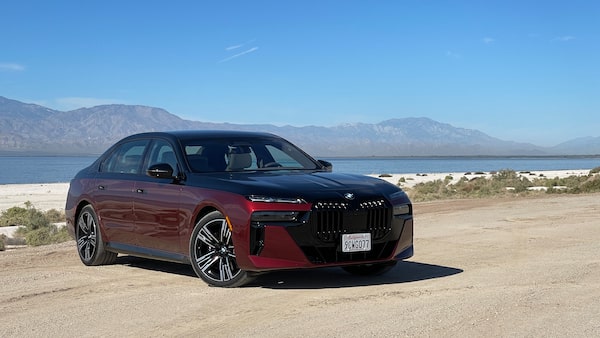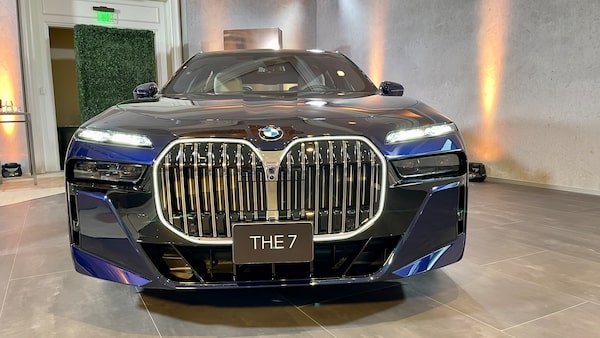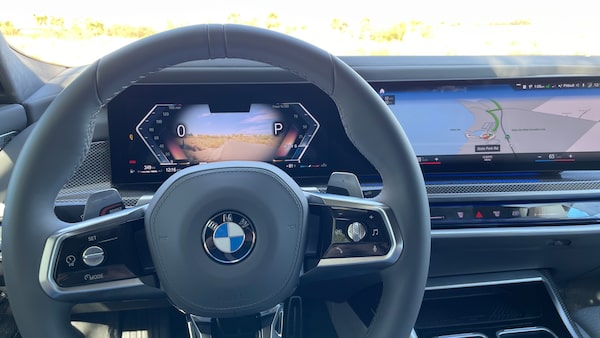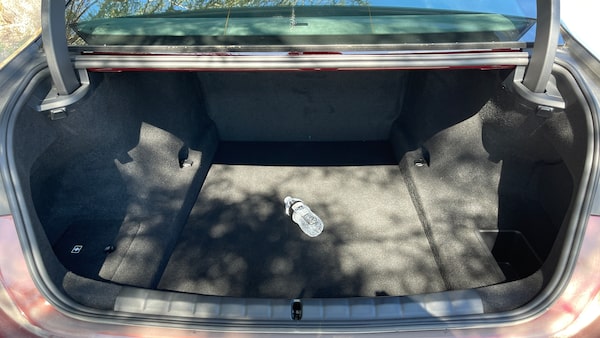
The 2023 BMW 760i.Mark Richardson/The Globe and Mail
There’s only one gasoline engine available for Canadians in the new BMW 7 Series, and it’s a powerful V8. But, for the same money ($147,000), you can buy the all-electric i7 with its two powerful motors, and – I can’t believe I’m saying this – that is almost certainly the way to go.
Other countries have other options, with V6 engines powered by either gasoline or diesel, including the 380-horsepower 740i that will be sold in the United States, but it’s all or nothing for Canada. At least for now: A plug-in hybrid, the 750e, will join the Canadian lineup some time later next year.
I can’t think of another vehicle for sale that offers the choice of gasoline or battery-electric for the same price, with essentially the same comforts and amenities. And there are many.
The big sedan, which was designed from the ground up to accommodate both the traditional gasoline and the all-electric powertrains, is now built on a bigger wheelbase – 13 centimetres longer than last year’s long-wheelbase model. It’s also slightly wider and taller.
Once you click the fob button to automatically open the driver’s door (or all four doors if you choose – they have sensors to make sure they don’t clunk into anything) and settle behind the steering wheel, you’ll barely know whether you’re in a gas or electric vehicle.
You’ll know when you drive it, though. Both vehicles make about the same horsepower and torque, but like all electric cars, the i7′s power is instant and surges forward without needing to drop through any of the gas version’s eight gears. On paper, it’s half a second slower than the V8 to 100 kilometres an hour, taking a swift 4.7 seconds, but it doesn’t feel like it.

The 2023 BMW 7 Series has a polarizing grille, with two huge kidneys that now look like swollen stomachs.Mark Richardson/The Globe and Mail
The slower acceleration is because of the added weight of batteries – the i7 weighs 370 kilograms more. The weight is low enough, however, that it’s satisfying to throw around a twisting mountain road. There’s no front trunk on the EV, because BMW put the front motor and other engineering wizardry under the hood.
The i7 has an official North American range of 512 kilometres. My fully charged test car showed an anticipated range of just over 500 kilometres in California’s warm weather, and this dropped slightly through a vigorous 300-kilometre drive, in which I averaged four kilometres per kilowatt-hour.
The battery is a 101.7-kilowatt-hour unit that BMW says will take 5.5 hours to fully charge at a typical 22-kilowatt Level 2 charger, or 34 minutes to 80 per cent at a Level 3 charger capable of 195 kilowatts. No rare earth materials are used in their production because, unlike most competitors, the i7′s two motors don’t have magnets. They use brushes and electrical current to rotate the stator, and it’s the magnets in more conventional motors that require rare earth materials.
The gasoline engine is a 4.4-litre twin turbo with 48-volt mild-hybrid technology that is used more for extra power than conserving gas. A decade ago, it would have been revered on an engineering altar. Perhaps it still will be, but it’s in the shadow of its electric sibling.

The 4.4-litre twin-turbo V8 under the hood of the 2023 BMW 760i.Mark Richardson/The Globe and Mail
Tech specs
- Base price/as tested: $147,000/$195,200 (estimated), plus $2,480 freight and predelivery inspection, and $595 retailer administration fee
- Engine: 760i: 4.4-litre twin-turbo V8 that makes 544 horsepower and 553 lb-ft of torque; i7: Two-motor electric, 258 horsepower front, 313 horsepower rear
- Transmission/drive: 760i: Eight-speed steptronic/all-wheel drive; i7: Single-stage fixed ratio/all-wheel drive
- Fuel economy (litres per 100 kilometres), 760i: 9.3 (combined); 11.6 observed
- Range/consumption, i7: 512 kilometres/19.6-18.4 kilowatt-hours per 100 kilometres (WLTP rating)
- Alternatives: 760i: Mercedes-Benz S-Class, Audi A8, Genesis G90; i7: Mercedes-Benz EQS, Tesla Model S
Looks
It takes a while to get used to that polarizing grille, with its two huge kidneys that now look like swollen stomachs. BMW says it wanted to give the 7 Series a “massive presence” and it’s certainly done that. The front doesn’t look out of place on the large sedan, however, and it’s not planned for the smaller 5 or 3 Series. If you like it, you can even opt to illuminate it with an LED surround, and you can add Swarovski crystals for an “iconic glow” to the daytime running lights. You have to buy the crystals as part of a package so it’s not clear just how expensive they are, but “they’re the real deal,” said a spokesperson. “They probably won’t be cheap.”
Special paint quickly adds up in cost: The matte colours, which BMW calls “frozen,” are an extra $4,900, and the two-tone option of the car in the photos here is an extra $12,000.
Visually, aside from the rear badge, the only real differences between the gas and electric vehicles are that the i7 has air curtains and active air vents in the grille. Good luck noticing those if one passes you on the highway.
Interior

The back seats of the 2023 BMW 7 Series.Mark Richardson/The Globe and Mail
It’s astonishing, even at the base level, with lots of wood and crystal and even an option of all-vegan materials. A new “interaction bar” runs the width of the front fascia and lights up at night in your choice of colour to match the cabin. It includes touch controls for adjusting the cabin’s temperature and can be set to change its glow to signal various things, such as whether it’s safe to open the door or when there’s an incoming phone call.
The real party tricks are happening in the back seat, and that’s if you pay for the options that are bundled together in expensive packages. The reclining rear seat that pushes the front passenger seat forward and pops up a footrest will require you to also buy the crystal headlights, massagers and sunroof, adding $13,500 to the price.
What you really want, if you want to impress, is the 31-inch 8K “theatre screen” that will cost an extra $6,900 on top of everything. Add an additional $5,900 if you want the Bowers & Wilkins surround sound speakers to go along with it. The screen folds down from the ceiling and will be wonderful if you’re being chauffeured somewhere and get stuck in traffic. If you’re the driver and your kids are watching it in the back, you’ll curse that it blocks your view in the mirror.
Performance

The dash of the 2023 BMW 7 Series.Mark Richardson/The Globe and Mail
There’s plenty of power in both drivetrains to impress at traffic lights, and adjustable air suspension is standard. Pay an extra $4,000 and you can have Active Comfort Drive Pro, which combines active roll stabilization with active steering.
I didn’t drive the 760i on twisting roads, but made up for it in the mountains with the i7 and the heavy car felt like a much smaller vehicle. It helped that it was fitted with the optional four-wheel steering, which turns the rear wheels by up to 3.5 degrees to quicken the turns and make parking easier.
Technology
BMW says the 7 Series will be certified as capable of Level 3 autonomous driving “soon,” but only in Germany and China. //Level 3 is when the driver needs to be behind the wheel, but can take their eyes off the road.
Most of the challenge to allowing Level 3 is local or national legislation, and when it finally comes to Canada, which it will, then the car will just update itself through an internet connection.
There are 30 sensors around the 7 Series, including high-resolution cameras, ultrasonic sensors and radar capable of seeing up to 300 metres ahead. They all work at up to 180 kilometres an hour, though the hoped-for Level 3 will only be activated in traffic at speeds up to 65.
Cargo

In the 2023 BMW 7 Series, there is 540 litres of trunk space in the gas car compared to 500 litres in the EV.Mark Richardson/The Globe and Mail
There’s lots of room in the trunk, though slightly more in the 760i than the i7, because the rear-axle electric motor gets in the way: 540 litres in the gas car compared to 500 litres in the EV.
The verdict
The new 7 Series is the next stage of luxury driving, especially for rear passengers cosseted by the lounge and theatre experience. It’s notable that the option of all-electric or internal-combustion is such an easy choice, for the exact same capital cost, though the maintenance and running of the i7 will certainly be less expensive. Take it from me: If you opt for the gas-powered model this time, you’ll want to replace it with the electric edition when the time inevitably comes.
The writer was a guest of the auto maker. Content was not subject to approval.
Shopping for a new car? Check out the new Globe Drive Build and Price Tool to see the latest discounts, rebates and rates on new cars, trucks and SUVs. Click here to get your price.
 Mark Richardson
Mark Richardson